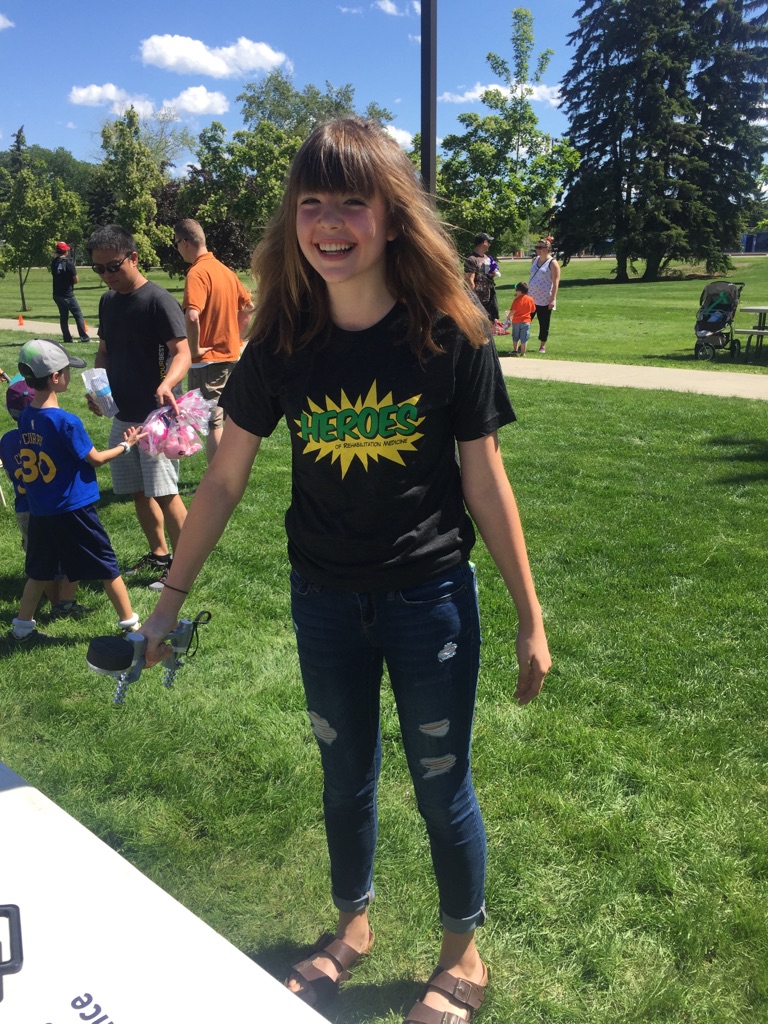
Willow Cleary, 14, said she enjoyed being able to test her grip strength.
Most children know what doctors or nurses do, but do they know what occupational therapists do? Rehab Med Family Fun Day, an alumni and community event, featured "rehab med booths" to raise awareness and show children what rehab professionals do.
In addition to bringing alumni and the community together, the event featured activities such as wheelchair assessments and races, grip strength tests and voice exercises, showcasing to children what physical therapists, occupational therapists, speech-language pathologists and rehabilitation scientists do to help the community.
"Rehabilitation is about helping people pursue their best, whether it's mobility through physical therapy, work and activities of daily living through occupational therapy or communication through speech-language pathology," said Bob Haennel, interim dean, Faculty of Rehabilitation Medicine. "Rehab Med Family Fun Day was just a, well, fun way we thought we could bring alumni and the community together, and teach kids a thing or two about rehabilitation."
Willow Cleary, 14, especially enjoyed the "gripping experience" booth, where her and her family tested how hard they could squeeze.
"I liked comparing between each family member," she said.
Family Fun Day also included face painting, balloon animals, and snacks such as cotton candy and popcorn.
The event served as a reunion for many alumni, some coming back to Corbett Hall with their kids, and even grandchildren, for the first time.
Amy Driga graduated from the faculty's occupational therapy program in 1999, and now works as an OT at the Cross Cancer Institute. She attended Family Fun Day with her two sons: Jeremy, 7, and Dominic, 5.
"I love having an opportunity to show the boys where I studied and spent so much of my time," she said.
Everyone received a "Heroes of Rehabilitation Medicine" t-shirt, including the babies and toddlers.
Positively Princess'd volunteered their time at the photo booth to raise support for the assistive technology and rehab robotics lab at the Faculty of Rehabilitation Medicine. They chose to support the FIRST LEGO League teams for children with and without disabilities, including autism.
"Thank you to all our student volunteers, to Guba and Patches, and to Snow White, Rapunzel and Tinkerbell," said Haennel, as he called up the princesses to help with the draw prizes. "It's great to have alumni and the community come together for a fun carnival-style event like this. We hope to see you again at Alumni Weekend!"
Rehab Med Booths:
Raise your voice for rehab med
- Speech-language pathologists can measure the intensity of people's voices: how loud or quiet they can be. Often they work with people who have disorders or diseases such as Parkinson's that make speaking in a loud voice difficult. Voices are measured in decibels using sound level meters. Event attendees got to test their voices!
Listen with your brain
- How do we receive sound from our environment and interpret it in our brains? Speech-language pathologists, audiologists and rehabilitation scientists study the structure of the human brain and ears in order to better understand how we communicate and how to help people with communication disorders. Kids were encouraged to study a model of the brain and ear to learn how they work together for us to hear.
The right way to write
- Occupational therapists work in schools with children who have difficulty holding a pencil. One of the ways they help children work on this is through writing or drawing exercises. Children tried out some fun writing and drawing tasks at this booth!
Dress it up
- Occupational therapists help people with disabilities and impairments in daily living activities such as eating, brushing their hair, or even getting dressed. Kids were asked to try using some assistive aids like a button hook and a long-handled reacher that are often given to clients to help them get dressed.
A gripping experience
- Physical therapists help people move and gain mobility and function. Sometimes people have a tough time grasping things in their hands, such as an apple or a water bottle. A physical therapist can use a grip strength dynamometer to measure how tightly a patient can grasp an object. Using the meter, children tested how hard they could squeeze!
Wheelchair flair
- People may need help moving around due to an injury, impairment or illness, and require a wheelchair. Children learned how occupational therapists and physical therapists can help a patient find the best wheelchair to fit their lifestyle, then were allowed to take one for a spin through our short obstacle course!
Hello, it's me. Your sense of hearing
- Audiologists and rehabilitation scientists study how we hear. Did you know we can hear through our foreheads and our noses? Volunteers demonstrated how the level of intensity changes when sound travels through the air and our bones. Sound also changes based on how different objects vibrate. Using different sizes of tuning forks, volunteers showed the kids how!